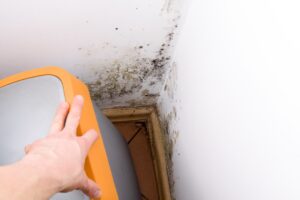The key to controlling mold is controlling moisture. In fact, a homeowners’ worst enemy is moisture and it can get into a home many different ways.
Are you aware of how many different ways moisture can get into your home?
According to the American Lung Association and the U.S. Consumer Product Safety Commission, one third to one-half of all structures have damp conditions that encourage the growth of mold and bacteria. This can lead to allergic reactions including asthma.
Now is a good time to check around the house for the presence of moisture.
Do Your Own Mold Diagnostics
If water is entering the home from the outside, you have a couple of different options, which include:
- Simple landscaping changes; or
- Extensive excavation and waterproofing.
Water in a basement or crawlspace can result from the landscaping around the house not being sloped away from the home or the landscaping may be built too high against the house.
Moving inside, take a look at the attic and see if there are any holes in the roof. Also, check and see if the attic is vented properly. Proper ventilation includes the soffits being clear and the vents are free of debris. Check the insulation for any type of traffic patterns that can be caused by raccoons, squirrels, birds, or mice. If there are signs of something living in the attic, the critters have to have a way to get in.
Improper ventilation causes condensation and moisture to build in an attic. Be sure to check the roof’s decking on the north side of the house which typically has the most potential for mold growth due to the lack of sunlight. You don’t want to find out you have a problem in your attic when you’re possibly getting ready to sell.
Mold and moisture is an issue that is a cause of concern for everyone buying or owning a home.
Your moisture check-up can help remedy the situation.
Clean Up Around the House
Gutters should be cleaned so there’s no build-up and possible overflow that could pour over the sides, into the landscaping and absorbed into the foundation. The gutters downspout should be clear and the flow of the water should be ejecting far enough away from the home so it doesn’t have an opportunity to soak into the ground. Also, the downspout should also be attached to the gutters.
If you have a dirt crawlspace, you should cover it with plastic or gravel and be sure that it’s properly ventilated. If there are pipes running through the crawl, you’ll want to insulate them to prevent condensation from the changes in temperature.
Use exhaust fans in the bathroom and the kitchen and be sure they’re vented outside and not into the attic. Also, vent your clothes dryer to the outside. Use dehumidifiers and air-conditioners especially in hot, humid climates.
Use insulation or storm windows. A storm window installed on the inside works better than one installed on the outside. Open doors between rooms, especially closet doors which may be colder than the room, to help increase circulation. Raise the temperature of cold surfaces where moisture condenses. Circulation carries heat to the cold surfaces. You can also increase air circulation by using fans and moving furniture from the wall corners to promote air and heat circulation.
It’s not advised to put carpet on concrete floors. Carpet will absorb moisture from the concrete and is a breeding ground for biological pollutants. In addition, if there’s padding, essentially you’re adding a sponge to the moisture equation. If there’s a flood, at the least, the padding will have to go. In certain climates, if carpet is to be installed over a concrete floor, it may be necessary to use a vapor barrier (plastic sheeting) over the concrete and cover that with sub-flooring to prevent a moisture problem.
It’s a good idea to turn off certain appliances (such as humidifiers or kerosene heaters) if you notice moisture on windows and other surfaces. Whole house humidifiers can cause excessive moisture if you don’t specifically follow the directions concerning its operation. Naturally, throughout the day, the temperature and humidity changes in a home. To set the whole house humidifier at a certain setting and leave it will cause problems by allowing excessive moisture in into the house. The directions on the humidifier state that it needs to be adjusted throughout the day to adjust to the changes in temperature and humidity.
Prevent Water from Coming Inside
Water in your home can come from many sources. Water can get in by leaking or seeping through the floors. Showers or even cooking can add moisture to the air. Temperature is very important. As the temperature goes down, the air holds less moisture. That’s why in cold weather, moisture condenses on cold surfaces. Knowing about moisture control can save you thousands of dollars in keeping your home from decomposing before its time. Now is the time to make time for a moisture check-up.
For more information regarding mold diagnostics or to schedule a moisture check-up, contact us today!







